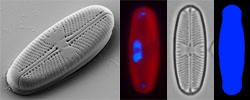Data related to J. Pérez-Burillo et al. (2021)
This page gives links to data used in the preparation of a paper published in Science of the Total Environment, available at this link.
"DNA metabarcoding reveals differences in distribution patterns and ecological preferences among genetic variants within some key species for diatom biomonitoring"
J. Pérez-Burillo, R. Trobajo, M. Leira, F. Rimet, J. Sigró, F. Keck & D.G. Mann
Abstract
Our study evaluates differences in the distribution and ecology of genetic variants within several ecologically important diatom species that are also key for Water Framework Directive monitoring of European rivers: Fistulifera saprophila (FSAP), Achnanthidium minutissimum (ADMI), Nitzschia inconspicua (NINC) and Nitzschia soratensis (NSTS). We used DADA2 to infer amplicon sequence variants (ASVs) of a short rbcL barcode in 531 environmental samples from biomonitoring campaigns in Catalonia and France. ASVs within each species showed different distribution patterns. Threshold Indicator Taxa ANalysis revealed three ecological groupings of ASVs in both ADMI and FSAP. Two of these in each species were separated by opposite responses to calcium and conductivity. Boosted regression trees additionally showed that both variables greatly influenced the occurrence of these groupings. A third grouping in FSAP was characterized by a negative response to total organic carbon and hence was better represented in waters with higher ecological status than the other FSAP ASVs, contrasting with what is generally assumed for the species. In the two Nitzschia species, our analyses confirmed earlier studies: NINC preferred higher levels of calcium and conductivity. Our findings suggest that the broad ecological tolerance of some diatom species results from overlapping preferences among genetic variants, which individually show much more restricted preferences and distributions. This work shows the importance of studying the ecological preferences of genetic variants within species complexes, now possible with DNA metabarcoding. The results will help reveal and understand biogeographical distributions and facilitate the development of more accurate biological indexes for biomonitoring programmes
Contents:
- Spreadsheet of all ASVs identified (by the Bayesian classifier) as members of the Achnanthidium minutissimum, Fistulifera saprophila and Nitzschia inconspicua species complexes, and Nitzschia soratensis, giving ASV number, species identity, DNA sequence, and the number of reads in each sample; a separate sheet lists the sample locations
Javier Pérez-Burillo, Rosa Trobajo and David
Mann,
IRTA Catalonia and Royal Botanic Garden Edinburgh
July 2021

 This site is
hosted
by
the Royal Botanic
Garden Edinburgh.
This site is
hosted
by
the Royal Botanic
Garden Edinburgh.